Mark Levinson 5805 Review
Mark Levinson 5805 is an amplifier (8) (7) that delivers 125W @ 8Ohm (6) (9) manufactured by Mark Levinson (2), which is an American company based in Connecticut (1). It has also an internal DAC (4) (5) (3).
Let me start by saying that this is the best amplifier that we have reviewed and that can be updated via firmware, so you would not need to replace this expensive device each couple of years.
The Mark Levinson 5805 is a completely discreetly built-in integrated amplifier based on a familiar Mark Levinson recipe: puristic and perfect down to the smallest detail and with a huge linear power supply. The class AB amplifier circuit delivers a comfortable 125W @ 8Ohm.
In terms of sound, the Mark Levinson 5805 with its extreme transparency, focus, and power go a long way towards the class of the larger No 585, which of course still outweighs it in control and scale. However, the Mark Levinson 5805 is priced a lot lower and therefore an incredible amount of Mark Levinson for its money. Equipped with 3 analog inputs, an MM / MC phono stage, and 4 digital inputs (including USB audio), this Mark Levinson 5805 gets an introductory price of 9,190 dollars.
The brand new Mark Levinson 5805 integrated amplifier, intended for both digital and analog sources, makes a truly ‘liberated’ impression. The new design for this 5000 series is tighter and visually less heavy, while the heavyweight of almost 30 kilos (66 pounds) and the solid construction are not exactly reminiscent of austerity measures. But where is the issue here? Because somewhere should it come out that less money has been spent? Once close, it is indeed noticeable that the always sharply drawing deep red display of the more expensive series at the Mark Levinson 5805 has a slightly more diffuse appearance.
A newly developed one Phono-Level has a hybrid Gain-Topology, the important discrete components the renowned Pure Phono stage of the 500 series with low-noise integrated circuits for high power combined at a lower cost.
Just like the 500 series, a hybrid active/passive RIAA Equalizer Precision resistors and Polypropylene capacitors for exceptional accuracy and clarity of sound. The user can select MM / MC gain and infrasound filter from the setup menu, while capacitive and resistive charge settings are easily accessible from the back.
Fortunately, legibility hardly suffers from this, while the informative character with alphanumeric characters has also been fully retained. Another part of which you can see that this design has been well thought out is the number of immediately visible features. Because the long row of pushbuttons made of solid aluminum on the front has disappeared, to make way for only two plastic ones. Nevertheless, the lion’s share of these functions can still be selected directly with the new very nice remote control, while the rest is housed in the exceptionally extensive and at the same time very user-friendly menu structure.
The latter in particular is something that many competitors can set an example for. Just take the extensive choices for switching the amplifier to standby. Of course, the ‘traditional’ standby mode is simply present, but there is also the additional option of leaving the amplifier ‘audiophile’ warm and switched on, with only the display and loudspeaker relays switched off. As a result, the device always performs at its peak and you do not always have to wait until it has warmed up completely. Yet this is only the tip of the iceberg because in many other aspects this Mark Levinson 5805 beautifully set to your liking and needs.
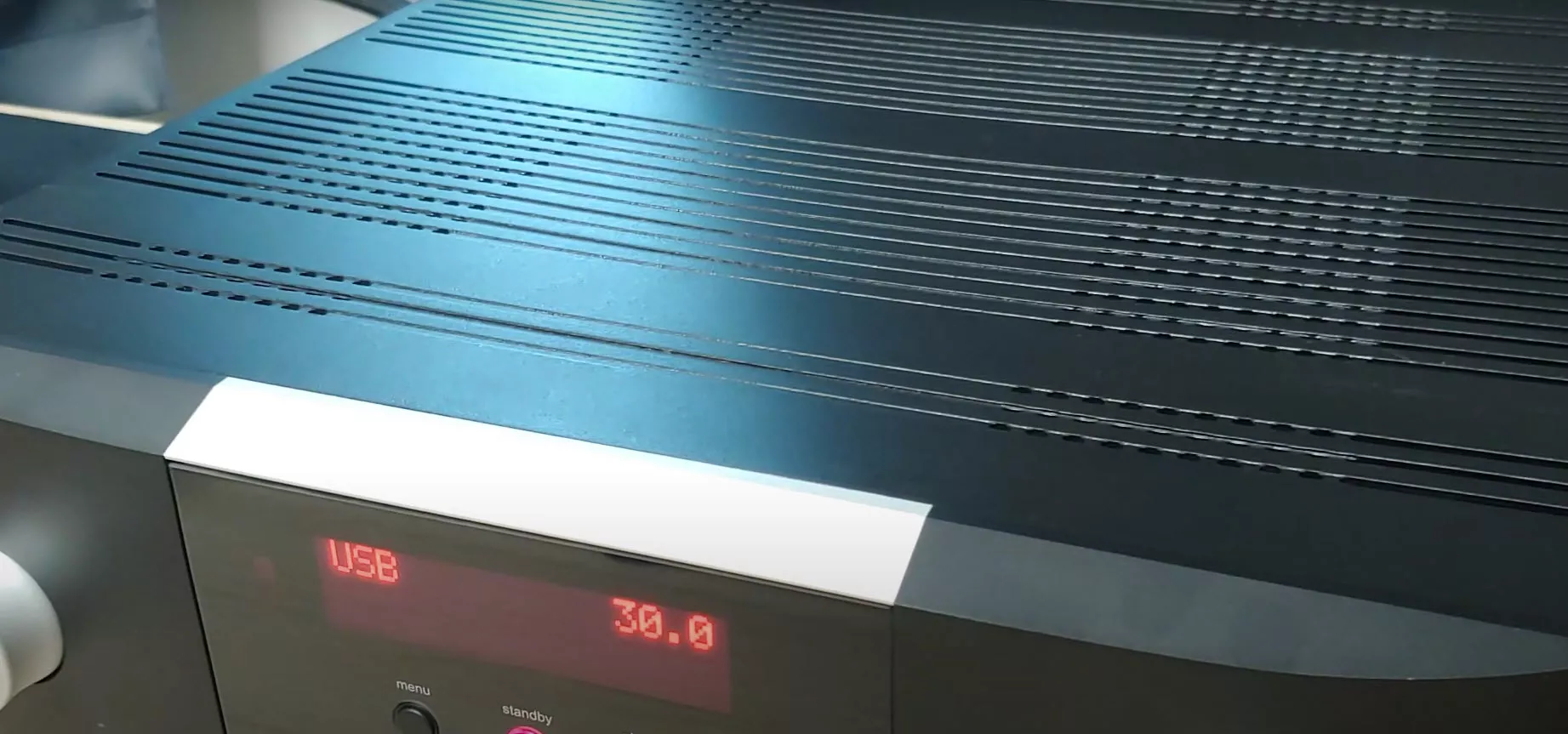
Pros And Cons Of The Mark Levinson 5805
Mark Levinson 5805 Pros And Cons
Pros
- A product that can last forever and does not need to be replaced with each new generation.
- Delivers a comfortable 125W @ 8Ohm.
- Equipped with 3 analog inputs, an MM / MC phono stage, and 4 digital inputs (including USB audio)
- Hybrid active/passive RIAA Equalizer Precision resistors and Polypropylene capacitors for exceptional accuracy and clarity of sound
- Modern, but at the same time keeping the Mark Levinson heritage style.
- The amplifier can also be set from a web browser using its Ethernet input. In this way, among others, we will update the firmware
- The digital part is based on the PrecisionLinkII system (used by ML in more advanced models) with a 32-bit ESS Saber Reference ES9018K2M digital-to-analog converter.
- The tonal balance is subjectively flat as a table. The treble is clear and can easily capture micro details.
- Four digital audio inputs are available: one coaxial and two optical S/PDIF- and an asynchronous USB-Connection for high-definition playback PCM- (up to 32 bit / 384 kHz) and DSD-Files (up to 11.2 MHz).
Cons
- Very expensive. Price of over nine thousand dollars.
- The upper part of the housing, made of sheet metal, with pressed ventilation slots. It is a pity that it was not decided to twist the housing with aluminum panels and “release” the heat sinks, i.e. move them outside.
Pros: Exemplary functionality and saturated, detailed, and spatial sound.
Cons: First of all, the price. In this context, the upper part of the casing made of bent sheet is slightly disappointing.
Overall: An integrated hi-end amplifier that you can stay with for years.
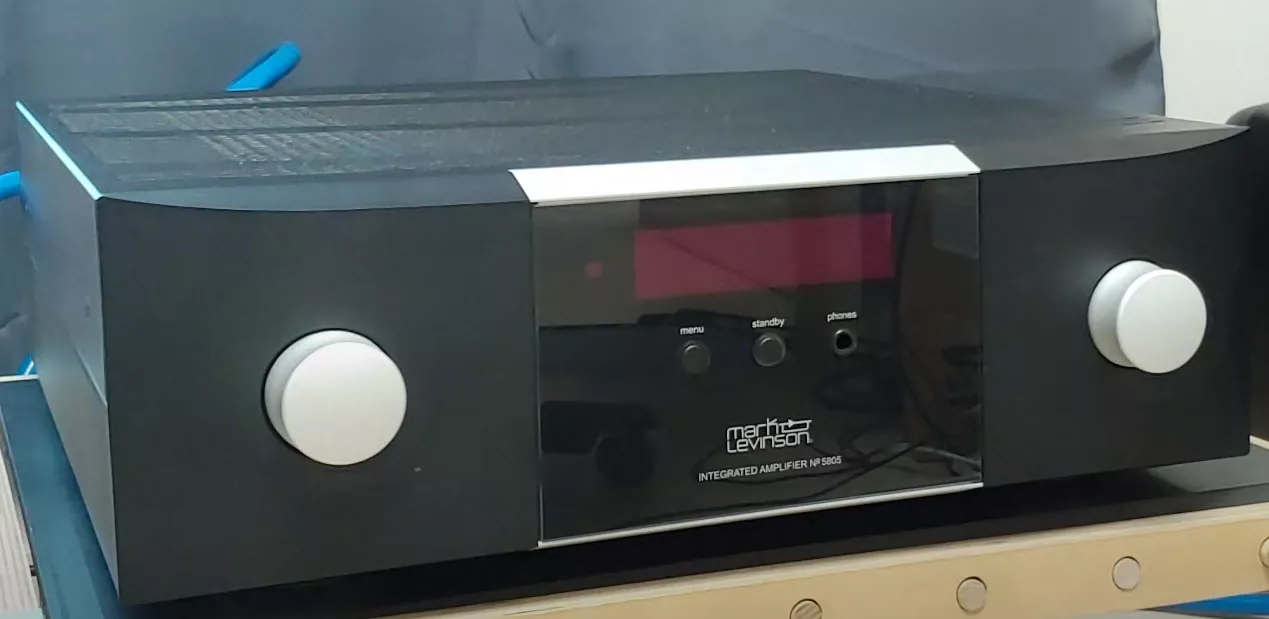
Ergonomics And Workmanship In The Mark Levinson 5805
Robust materials, elaborate surfaces, and a striking geometry are the Mark Levinson designs. The 1-inch thick, pearl-blasted, black anodized, solid aluminum front panels are machined and contoured to flow seamlessly into the slim glass display, which in turn is embedded in a clear anodized aluminum bezel.
Mark Levinson 5805 is a combination of old and new. A part of the “heritage” referring to older Levinson devices has been preserved, but a step towards modernity has also been made. The front, black anodized panel is carved from solid 25mm thick aluminum and connected to the glass surface integrated with the dot-matrix display. It shows the selected input and volume, and when using the USB input, after pressing the enter button on the remote control, also the type of file and its frequency (e.g. PCM 96k, DSD 4X).
From the top and bottom, the glass pane is closed by silver aluminum inserts, which harmonize nicely with the anodized, sandblasted knobs with a concave profile – elements that are strongly associated with the ML brand. The ones on the left choose the entries and navigate through the extensive menu (see below), and on the right, we change the volume and confirm (by pressing) the menu selection. Operation is simple but requires some practice.
The legendary Mark Levinson hourglass buttons are redefined – processed with a gently curved profile that merges into a round front with matching feet. With embossed ventilation openings for the top cover, a screen-printed logo behind the glass pane, and aluminum buttons, no detail was overlooked. An elegant, customized infrared remote control of the 5000 series made of aluminum is included.
In addition to the knobs mentioned above, it is enabled by two aluminum buttons: menu and standby (the latter has a red, illuminated border that flashes in standby mode, which unfortunately cannot be turned off). There is also a shapely aluminum remote control, designed especially for the 5000 series, which if necessary can be replaced with a mobile device with iOS (download the free application “5Kontrol”).
The amplifier can also be set from a web browser using its Ethernet input. In this way, among others we will update the firmware, import or export the selected configuration, check the temperature of the power terminals, positive and negative value of the power bus, settings for DC Offset and review the settings for fault history (in the form of a log).
The back of the integrated reflects a stacked laminate system and dual-mono construction. At the top are the analog inputs. Three are linear, including one balanced (XLR), and two are for the turntable – one is for MM cartridges and the other for MC. Next to it are microswitches for impedance (positions 1-4; 37, 43, 52, 62, 82, 90, 110, 125, 250, 500 and 1000Ω) and input capacity (positions 5 and 6; 20, 70, 120 and 170pF). There is also a line output on the same line. It can be used to send a signal to the amplifier and loudspeakers working in the second zone, or to the recording device. The middle row of sockets are single speaker outputs and digital inputs between them: USB-B, two optical and one electric (coaxial). On the lowest level, i.e. control (in the vicinity of the power socket and main fuse),
Fortunately, as befits a true Mark Levinson, the new beautiful ‘streamlined’ two-tone front panel is still adorned by the ‘hourglass’ knobs, which are so characteristic of the brand, made of solid aluminum. Controls especially combined for the new series for the first time with matching feet with the same profile. Although the headphone output for the first time on a Mark Levinson amplifier already hints at the remarkably rich equipment, the basis of this amplifier still forms an oversized (500+ VA) toroidal transformer. A large specimen with individual secondary windings for both the left and right channels.
Together with four, 10,000 microfarads ELCO’s mounted directly on the starting sprint, this is what the Mark Levinson 5805 (43.8 cm high, 14.5 cm high and 50.7 cm deep) for 2 x 125 Watt at 8 Ohm, approximately 2 x 250 Watt at 4 Ohm, and still a stable power delivery at 2 Ohm. The topology of the voltage gain from the Levinson No.534 power amplifier is coupled to an output stage with eight transistors, two of which operate in Class A.
The output phase bias is automatically temperature corrected, which certainly contributes to the particularly great consistency in the sound. I think it is really special the aim of the design team to not just haphazardly put the cut-back knife into the design, but to try to make the circuit work more efficiently with fewer required parts by ‘cleaning up’ and smart thinking.
The actual basis is the completely newly designed ‘PurePath’ signal path. A fully discreetly constructed, direct-coupled, line-level dual-mono preamp, for which the Shelton design team is pending two patents. Furthermore, the design features a unique single gain stage that is linked to a digitally controlled resistance network for volume adjustment in the analog domain and for all analog inputs.
The volume control for the digital inputs is done on it Furthermore, the design features a unique single gain stage that is linked to a digitally controlled resistance network for volume adjustment in the analog domain and for all analog inputs. The volume control for the digital inputs is done on it.
Furthermore, the design features a unique single gain stage that is linked to a digitally controlled resistance network for volume adjustment in the analog domain and for all analog inputs. The volume control for the digital inputs is done on its DAC board and with its own, extremely precise digital volume control. The signal paths are thus kept very short and efficient. Finally, the Mark Levinson 5805 automatically selects the correct volume control determined by the selected input: digital or analog.
The element that at this price of the amplifier does not shine especially is the upper part of the housing, made of sheet metal, with pressed ventilation slots. It is a pity that it was not decided to twist the housing with aluminum panels and “release” the heat sinks, i.e. move them outside. Such solutions can be found in some much cheaper integrals, such as Cambride Audio Edge A or Norma Audio REVO IPA-140.
Digital Part Of The Mark Levinson 5805
Now that we know that the analog part of this amplifier is of top quality, this new star in the firmament also appears to be equipped with a particularly high-quality digital part.
The digital part is based on the PrecisionLinkII system (used by ML in more advanced models) with a 32-bit ESS Saber Reference ES9018K2M digital-to-analog converter.
Mark Levinson himself calls it PrecisionLink II DAC, in which a latest-generation ESS Saber 32-bit D / A converter with jitter elimination circuit and a fully balanced, discrete current-to-voltage converter is at the heart of digital signal processing. In addition, the options have been expanded. For example, there are four digital inputs, including one coaxial, two optical S / PDIF, and an asynchronous USB for playing high-resolution PCM (up to 32 bit / 384 kHz) and DSD (up to 11.2 MHz) files.

REMOTE CONTROL OF THE MARK LEVINSON 5805
Finally, the Mark Levinson 5805 includes MQA (Master Quality Authenticated) technology, which allows MQA audio files and streams to be played. Finally, a receiver equipped with aptX-HD completes the digital part by enabling Bluetooth playback in the highest quality.
If the above options are sufficient for you and you no longer use analog sources, then you may already be satisfied with the Mark Levinson No. 5802 integrated amplifier for digital sources only. It also has an additional coaxial and balanced (AES / EBU) digital input, which provides the Mark Levinson 5805 does not have.
Phono preamp In The Mark Levinson 5805
Just while you might expect that we will now be there for the requested amount in terms of possibilities, the Mark Levinson 5805 also has a high-quality Phono preamp to be built in. Like the rest of the amp, this addition has also been designed from scratch and features hybrid amplification topology. Within this development, discrete components are combined with the acclaimed 500 series Pure Phono modules.
Building blocks that take advantage of the low noise level of integrated circuits for high performance at a lower cost. Like the 500 series, a hybrid active/passive RIAA equalizer uses precision resistors and polypropylene capacitors intended for maximum accuracy and transparency.
Connectivity Options
Finally, we come across easily accessible dip switches at the rear. This makes it a piece of cake to set the capacitive (4x for MM) and resistance value (12x for MC) per element. Despite all these connectivity options, the development team has once again succeeded in creating a model of clarity. Add to that the very solidly constructed housing and sleek finish and it is clear that Mark Levinson has managed to achieve almost the impossible for this amount.
Include system integration and communication ports Ethernet, USB, RS-232, IR input, and 12V trigger input and output. A newly developed, massive IR remote control made of aluminum is included in the scope of delivery of the Mark Levinson 5805.
Finally, an internal website enables the configuration, import, and export of configurations and Software-Updates with a PC and a standard web browser. Be beyond driver available from third parties.
Utilized Components
The key question now is whether all efforts have ultimately resulted in the reproduction being just as special. To determine that, the Mark Levinson 5805 both Kroma Audio Julieta and reference Master Contemporary C loudspeakers.
As sources, I have to thank the Audio department of El Corte Ingles, I used a Naim ND 555 with dual power supply and Merging + Player, + Power and + Clock as a music server and the extremely proven North Star Design 192 MK 2 CD transport with Extremo DAC played the CD preserves.
As amplifiers, price-wise reasonably equivalent competitors such as a Hegel H590, Moon 600i v2, and Accuphase E-650 can give the Mark Levinson a good match, while the reference Zanden 6000 has been used in the final period to ensure the absolute quality of the Mark Levinson 5805 to scale.
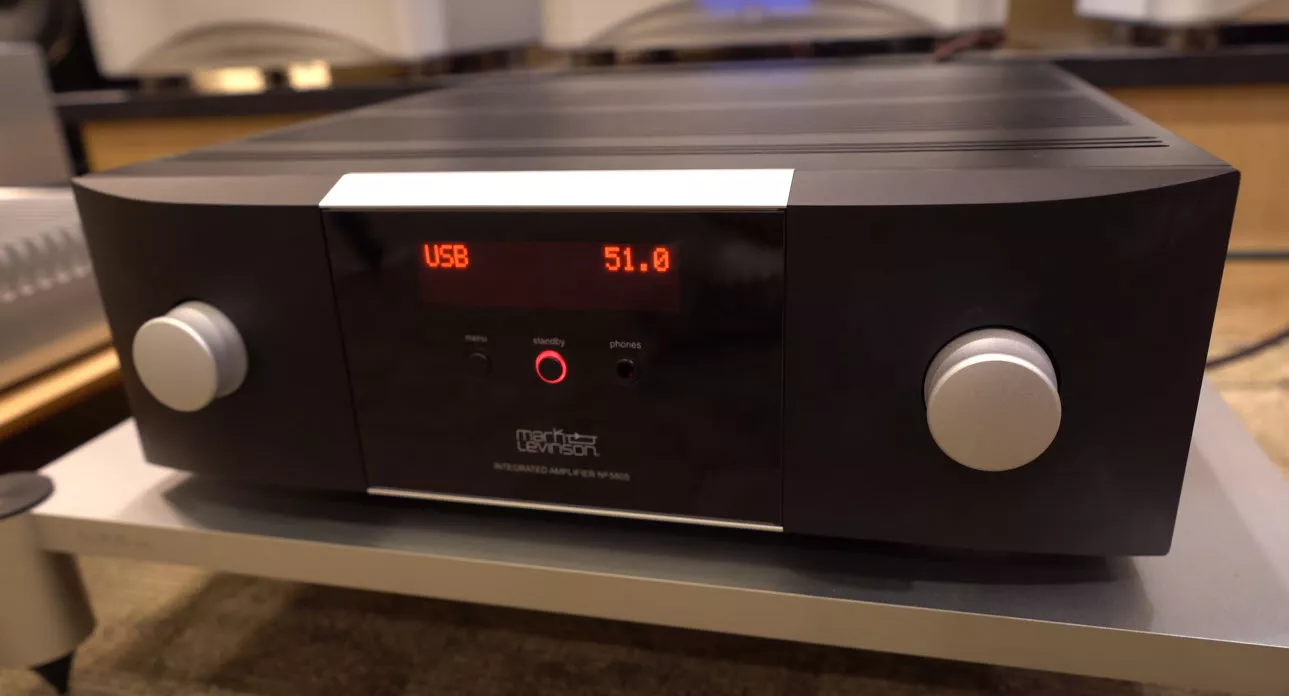
COMPLETE SETUP THANKS TO THE AUDIO DEPARTMENT OF EL CORTE INGLES WHO ALLOWED US TO REVIEW A UNIT.
Although it is tempting to start immediately with the built-in DAC, I still decide to start with the analog inputs in the first session. Not only because I know the sources present here from oats to grits, but also because I want to determine how well this amplifier is able to show the difference between all available sources. But just while you may think that this encourages technical listening, something completely different happens during these first musical notes.
It is certainly true that transistors have undergone a clear evaluation in recent decades. But because new insights also provide better results for the other design parameters, even the tube-typical properties are now increasingly within reach. In the case of this Mark Levinson 5805, this is reflected in the fact that from the first second a very fine absence of so-called ‘grain’ is visible.
This immediately gives music and voices a remarkable naturalness and plasticity, while the absence of ‘voicing’ also ensures a very special listening experience. It is so good that I have never seen it in this price range before.
It must be said that the more expensive and larger Mark Levinson No. 585 amplifier, an important part of this tuning. Yet… provides a very special listening experience. It is so good that I have never seen it in this price range before.
Audio Quality
As no other integrated amplifier in this price range, the Mark Levinson 5805 to translate this purity and integrity into real musical communication. No subtlety escapes his attention, especially the subcutaneous message that comes across as unprecedentedly good, and during the review hour of the device, I never got the feeling that I was listening to an electrical component.
The timbre, whether of individual instruments or of the human voice, is natural, rich in details, but smooth, devoid of roughness and sibilants. The sounds are slightly rounded, but the colors are neither insulated nor chilled. The tonal balance is subjectively flat as a table. The treble is clear and can easily capture micro details.
Turned into practical examples, it is, therefore, no surprise that this newcomer has no difficulty in depicting the intrinsic properties of the various sources. For example, the Naim ND 555 shows 3D panoramic in its characteristic way, with beautiful round, full and powerful timbres and pronounced dynamic contrasts. The Merging stack, in turn, shows how extremely transparent, coherent, and natural digital can sound today. While the NSD combi traditionally shows how involved, colorful and of course top CD playback can still sound even in 2020.
Just like with the more expensive Mark Levinson No. 585 was the case, also owns the new Mark Levinson 5805 again that difficult to describe lightness in the layer. It is not that the display is slim or restrained in this area, but rather that it is not emphasized and the speed fully matches the rest of the spectrum. Typically Levinson is that overall coherence is also more important than highlighting or emphasizing a single aspect. Very nice is that this impression is also completely independent of the chosen volume setting, the character never or never comes across as ‘transistor dry’ and that with more volume required, you can also increase (or decrease) the gain of the preamp section even further under the skin.
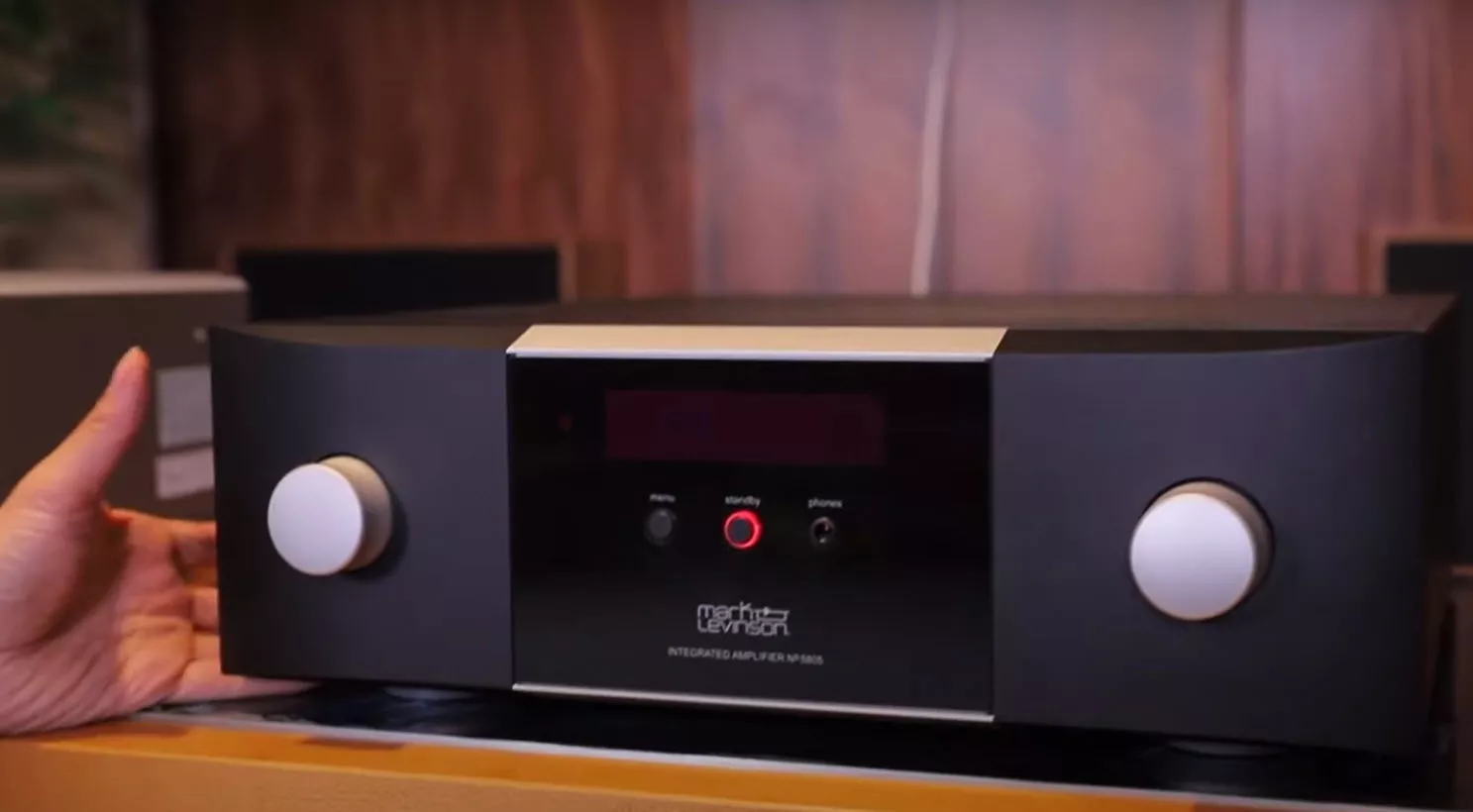
DAC Functionality
Before I switch to the built-in DAC functionality, I would like to emphasize that all digital sources I use are extremely good and, after the NSD combi alone, are much more expensive than the complete Mark Levinson 5805. In that light, it is not surprising that the total level when using this DAC after the analog inputs does drop somewhat. It all becomes more direct, a bit more up-front, less deep and less colorful in character. However, it soon turns out that it fits completely within its price range and that this DAC does perform very well and well within that pattern.
Four digital audio inputs are available: one coaxial and two optical S/PDIF– and an asynchronous USB-Connection for high-definition playback PCM– (up to 32 bit / 384 kHz) and DSD-Files (up to 11.2 MHz). The Mark Levinson 5805 has the MQA-Technology (Master Quality Authenticated), which enables the playback of MQA audio files and streams. A with aptX-HD equipped Bluetooth-Receiver enables the best possible Bluetooth playback.
So there is certainly a lot of fun to experience with this whole. Fun that can be further enhanced by MQA (Master Quality Authenticated) -play encoded software and look up the limits at PCM up to 32 bit / 384 kHz (DXD level) or DSD up to 11.4 MHz.
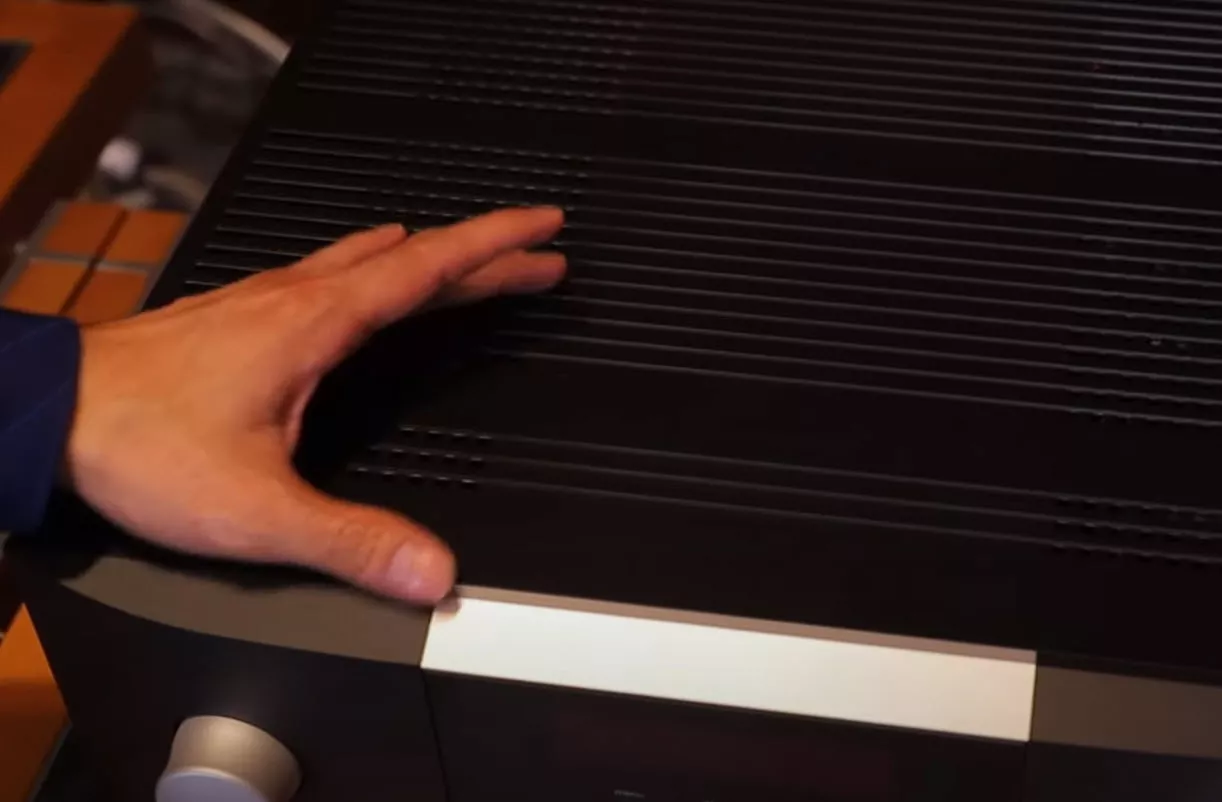
IT GETS A BIT HOT IN THIS UPPER PART……
Because the built-in DAC also has seven PCM and four DSD different filter settings, it is possible to subtly enhance or attenuate certain properties.
Don’t expect worlds of difference, but it can certainly put the finishing touches. Another special feature that you rarely encounter with high-end amplifiers is the Bluetooth aptX-HD option. A ‘super variant’ touted as ‘lossless’ and should be capable of a really serious rendition. Of course, there is an issue here because you can only use aptX-HD if the source device also supports it. But at the moment that is only a handful of Android devices and iPhones since early 2021.
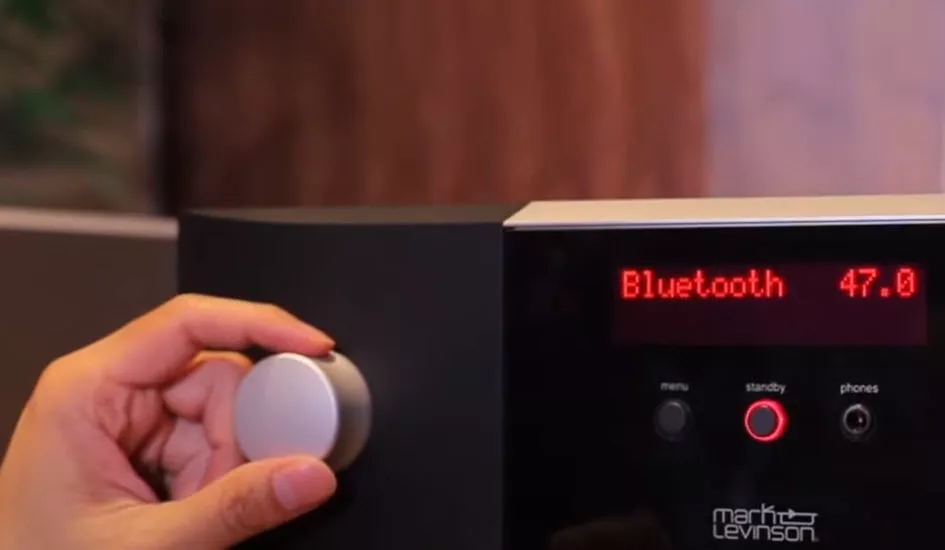
The sometimes very violent dynamic contrasts are, just like the power in the layer, definitely seen a bit more shy and less pronounced than is possible, but you only notice this when you compare A / B with even better and especially more expensive amplifiers. But certainly, within this price range and the rich equipment level, the many advantages far outweigh the few minor points.
Power
The power supply is complemented by four 10,000µF capacitors per channel (the amplifier has a dual mono structure), located directly on the output circuit boards. The power amplifiers use three pairs of transistors working in class AB in the ThermalLink mode (with compensation of the temperature effect on their characteristics).
The voltage section borrows solutions known from No. 534. The preamplifier, in turn, is a redesigned version of the PureDirect circuit used in model No. 585. MAS6116 Micro Analog Systems, previously known as WM8816 (Wolfson), is responsible for the gain control. It has very good parameters (THD 0.0002%; S / N 124dB for differential configuration, i.e. one circuit per channel), which has already been appreciated by such manufacturers as e.g. Marantz (PM15S2 amplifier for example).
So the fully discrete, directly coupled Class-AB- Amplifier channels receive their power from an oversized (500+ VA) toroidal transformer with individual secondary windings for the left and right channels. The voltage amplification stage uses a topology derived directly from the famous amplifier Nº 534 which is connected to an output stage which is the two high-speed driver transistors of the class A and six 260V, 15A output transistors. Two thermal track devices in one-configuration guarantee a stable output bias regardless of load and temperature. Four 10,000 microfarad capacitors per channel, located directly on the PCB Power amplifier easily supply enough power for a conservative 125W / channel to 8 Ohm, almost 250W / channel at 4 ohms and stable operation up to 2 ohms. Variable line-level RCA- Outputs enable system expansion and flexibility.
Conclusion
The Mark Levinson 585 was already very good in 2015: the very extensive package of possibilities, the beautiful solid construction, and a display that made the technology quickly forgotten. Also on the Mark Levinson 5805, all of these qualifications continue to apply, yet they are different. Yes, the build quality is certainly a little less exquisite if you compare directly than its bigger and more expensive brother. While fewer things are built up completely discreetly under the hood.
The advantage, however, is that the designers have dealt with the lower cost price very differently than usual in order to think in terms of motivation and much more in smart solutions. Ultimately, this has led to both visual and subcutaneous minimalism, but still with a maximum number of uses.
The DAC functionalities are also very extensive and the quality is fully consistent with an amplifier from this price range. Summarizing all this, Mark Levinson has pushed his limits again. Because bringing a top-class amplifier for a lot of money is no easy task, but it becomes even more difficult when you are able to market the same qualities for considerably less money and almost no concessions. Mark Levinson 5805 with verve, so that a new leader has emerged in this fiercely contested price range.
Mark Levinson 5805 9,190 dollars
Mark Levinson No. 5802 7.990 dollars
Product Specifications
– Output power: 2 x 125W at 8Ω.
– Headphone output with MainDrive ™ support.
– Four digital inputs: 2 x Optical (Toslink), 1 x coaxial (S / PDIF), 1 x asynchronous USB with PCM support 32 bit / 192 kHz, DSD 5.6 and MQA MQA decoding on all digital inputs, including an asynchronous USB input
– Bluetooth with AptX-HD.
– Floating RCA stereo pre-out.
– Five analogue inputs: 1 x XLR, 2 x RCA, 1 x Phono RCA (MM), 1 x Phono RCA (MC)
– Headphone output 1/4-inch / 6.35mm jack on the front panel
– Pair of high-current speaker outputs
– Designed and precisely assembled in the USA
– 20 Hz-10kHz attenuation coefficient:> 82
- Signal / noise ratio: 103 dB
- THD distortion + noise: <0.035% for 1kHz, 125W, 8Ω; <0.18% at 20kHz, 125W, 8Ω
- External dimensions height / width / depth: 14.5 x 43.8 x 50.7 cm.
- Weight: 28.1 kg.
Further Readings
We have some other interesting articles for you to read, we have selected our top articles below, and tried to keep this list short.
We have a technical vademecum where we discuss industry terminology and how it can be useful for you. Selected examples are the definition of PCM audio, then comes the comparison between PCM and Bitstream, the comparison between DTS Neo 2.5 and Dolby Digital, and the process to match amplifiers to speakers.
Also, we have reviewed some interesting DAC: The Elgar Plus from dCS, and the Schiit stack. where the Modi 3 behaves as an entry-level DAC.
In our reviews of AV receivers, we can recommend you to read some of our favorites, the ones that we liked the most, and trying to make the list short, we have the Denon AVR-X2500H, the Onkyo TX-NR686. We also have reviewed completely the Denon 8K receivers where we have studied the 8K Denon AVR-X2700H, the Denon AVC-X6700H, the AVC-X4700H, and the AVC-X3700H.
If you are into amplifiers, my favorite is the McIntosh MA9000, and that is why I would like to recommend you to read that review. My second favorite amplifier is the Mark Levinson 5805.
Regarding speakers, we have reviewed tiny bookshelf-speaker devices to large towers. My favorites were: the Devialet Gold, the Devialet Silver, the ProAc Response DT8, the Bowers and Wilkins 805 D3,
We do not review many headphones, but if you want a Sennheiser headphone for less than 100 dollars, we have this Sennheiser HD595 review.
We have some TV and monitor reviews and here we recommend the Samsung NU8000 (for gamers!) and my favorite is the review of the classical Pioneer Kuro.
Our home theater aficionados want to know everything about video definitions and configurations. So we studied 720p, how to scale it to 1080p the right way, and compared 1080p with 1440p and demonstrated why 1440p is not always better. Likewise, we had the urge to compare 1440k with 4K and try to find out how much are we gaining with the change.

I am Bob. I work as an audio engineer and audio technician. I work in mastering and arranging bridges in existing songs and the arrangement and orchestration of the chorus. In Planet HiFi I test gear for a couple of days and write a review. I also write about AV topics, amplifiers, speakers, and headphones.

